Center Points
Welcome!
Let’s meet a few recent additions to our full-time staff. They all began their full-time career with the Carrington REC in March 2020, so we are overdue with introductions.
(In alphabetical order…)
Harley Burgard is a Field-Lab Research Technician in our agronomy program where she continues to provide support to our research programs. She balances her time between the Lab and the field depending upon priority projects. Harley gained much experience operating the research planters by the end of spring planting! Harley started at the Carrington REC as part of our summer crew for multiple field research seasons. She also provided a ‘bridge’ in coverage during the winter when other staff changes occurred in our Lab.
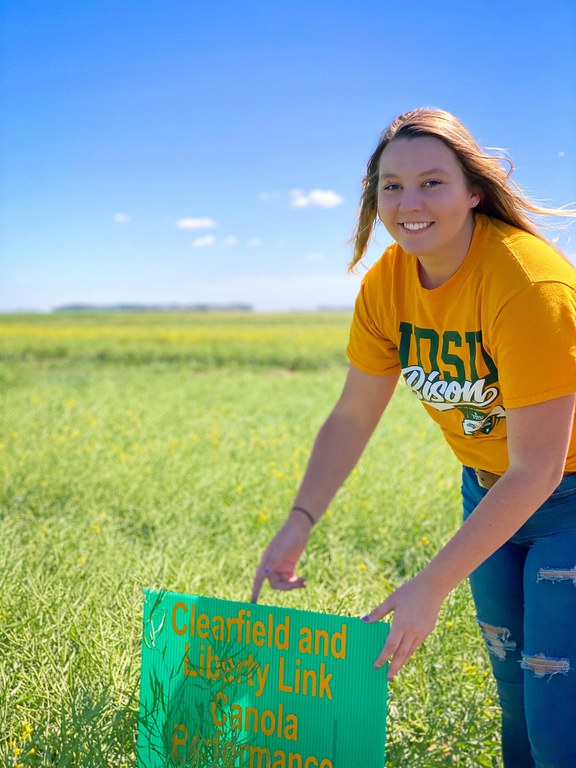
Harley Burgard is a Field-Lab Research Technician in our agronomy program at the NDSU Carrington Research Extension Center.
Jesse Hafner is a Research Specialist on our Plant Pathology team. Jesse is a recent graduate of NDSU (December 2019, Bachelor of Science in Crop and Weed Sciences) who worked summers at the CREC before taking on more responsibilities and working remotely from campus prior to his graduation. Jesse works closely with droplet size studies.
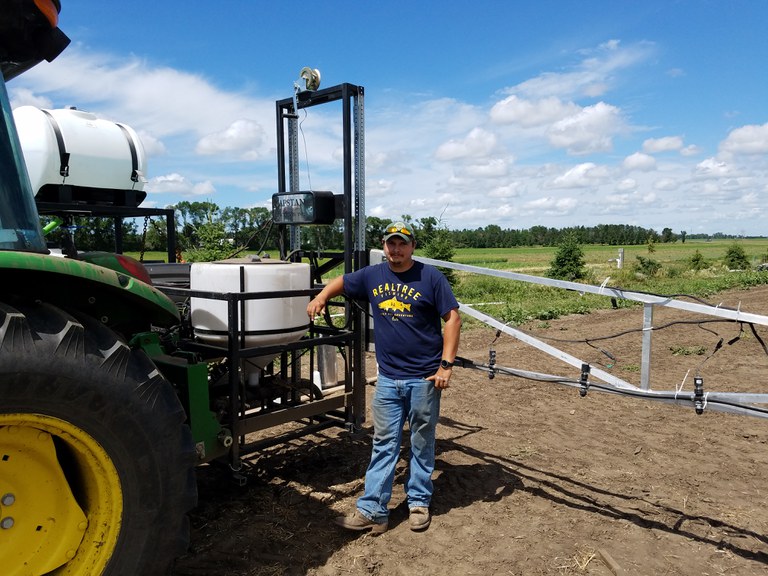 Jesse Hafner is a Research Specialist on our Plant Pathology team at the NDSU Carrington Research Extension Center.
Jesse Hafner is a Research Specialist on our Plant Pathology team at the NDSU Carrington Research Extension Center.
Melissa (Missy) Hafner is the Agronomy Laboratory Manager-Specialist. She directs the preparation of crops and soils experiments for planting in the spring and manages the processing of samples coming in during the season and after harvest. Her responsibilities extend to field research tasks. Missy worked as a grain quality coordinator at Dakota Growers Pasta Company for many years before coming to the CREC. Missy is also one of the co-founders of JunkFest, an annual vintage market festival featuring makers, vendors, and artisans, held each fall in Carrington.
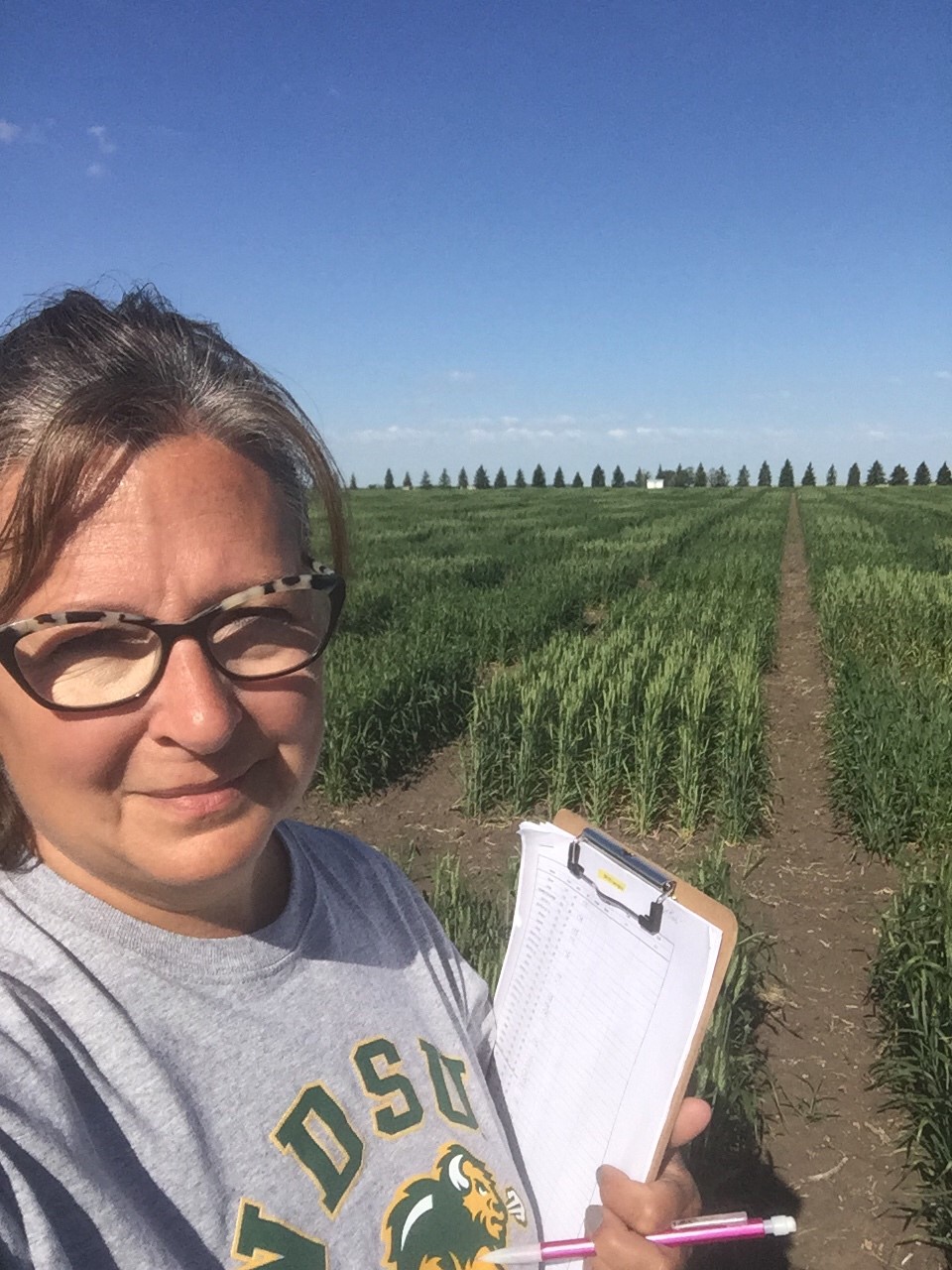 Melissa (Missy) Hafner is the Agronomy Laboratory Manager-Specialist at the NDSU Carrington Research Extension Center.
Melissa (Missy) Hafner is the Agronomy Laboratory Manager-Specialist at the NDSU Carrington Research Extension Center.
Billy Kraft is now a Research Technician in our seedstocks and agronomy programs. Billy’s history with the CREC began as part of our summer crew, before joining our Plant Pathology team full-time where his specialty became keeping miles of misting systems functioning as part of fungicide trials. Billy now provides support for all phases of foundation seedstocks production. As harvest of the first 2020 foundation seed increase fields will soon begin, Billy will be gaining further experience operating the new seed plant under the careful direction of Dave Copenhaver.
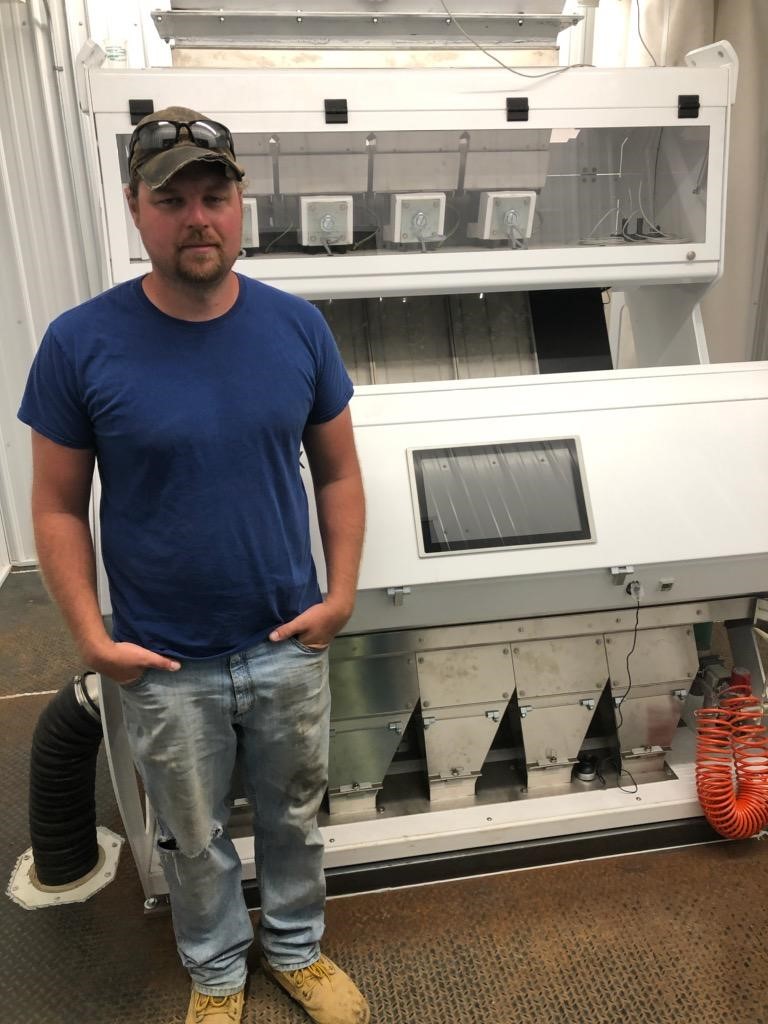 Billy Kraft, Research Technician at the NDSU Carrington Research Extension Center.
Billy Kraft, Research Technician at the NDSU Carrington Research Extension Center.
Linda Schuster
Linda.Schuster@ndsu.edu
Administrative Secretary
Organic Intercropping Research at the CREC 2020
Intercropping is the practice of growing two or more crops together at the same time in the same field. The idea is to find combinations of plants that complement each other or perform better than when planted alone. Intercropping can lead to increased yield and quality compared to mono-cropping. Agronomic benefits from intercrop mix combinations include weed and disease suppression, along with an impact on nutrient availability. An example of two plants that benefit each other is oat pea where the oats provides support for the pea with the pea providing nitrogen to the production system. Important considerations for intercropping include: proper seeding rate/plant density for each component of the mix and variety selection to match maturity dates.
This season the organic project has two intercrop trials and a demonstration plot of intercropping. They include the oat/pea for grain trial, new this year is a wheat/flax intercrop trial and we also have a 3 sisters demonstration planted. Results will be available from these trials at a later date.
This is the third year for the oat/pea trial with slight changes made for this growing season. This year the trial is looking at more pea and oat varieties and varying the seeding rate less. Oat varieties include: Rockford, Camden and Summit. The pea varieties used are Proteca, Nette and Orka. Seeding rates for peas remain at normal (350,000 PLS/ac) across all treatments with the oats rate varying from 50 to 100% (100 % = 1,250,000 PLS/ac). The trial was planted on May 11, 2020. The oat/pea study from 2019 was written in the CREC Annual Report. You can find it by going to this link https://www.ag.ndsu.edu/carringtonrec/documents/agronomyrd/docs-2019/intercropping-oats-and-field-pea-in-an-organic.pdf. If you have a hard copy of the Annual Report you will find it in Volume 60, December 2019, pages 17-20.
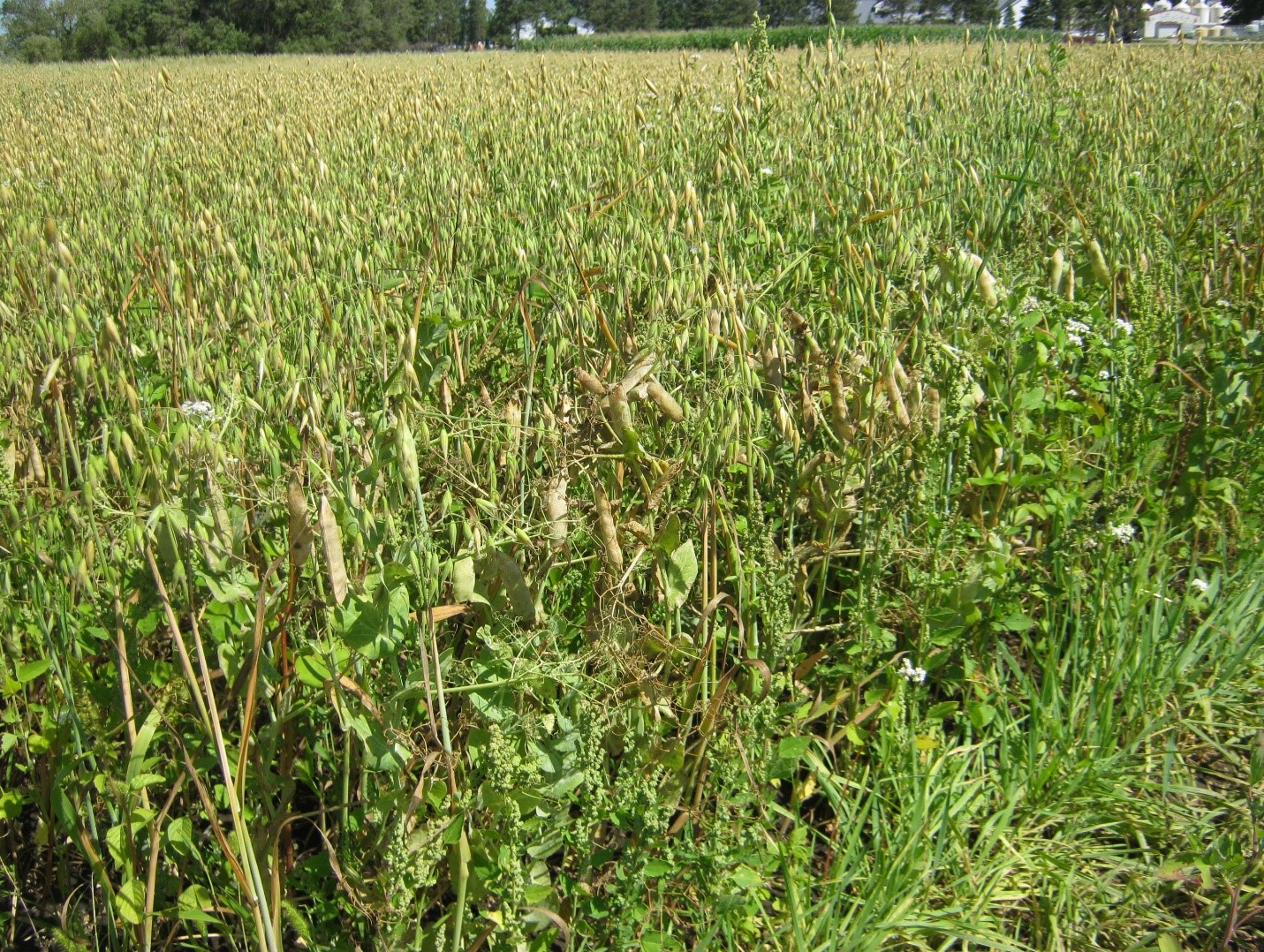 Oat/pea intercrop on July 22 starting to dry down at the NDSU Carrington Research Extension Center.
Oat/pea intercrop on July 22 starting to dry down at the NDSU Carrington Research Extension Center.
The wheat flax intercrop trial was planted on May 18 and includes 2 varieties of wheat and flax. Wheat varieties include FBC Dylan and Glenn. Flax varieties are yellow or golden Omega and the new NDSU release, ND Hammond. This trial was a tour stop on our Annual Field Day tour that was done virtually this year. You can find it here https://www.ag.ndsu.edu/CarringtonREC/field-days/Organic-sustainable%20agriculture.
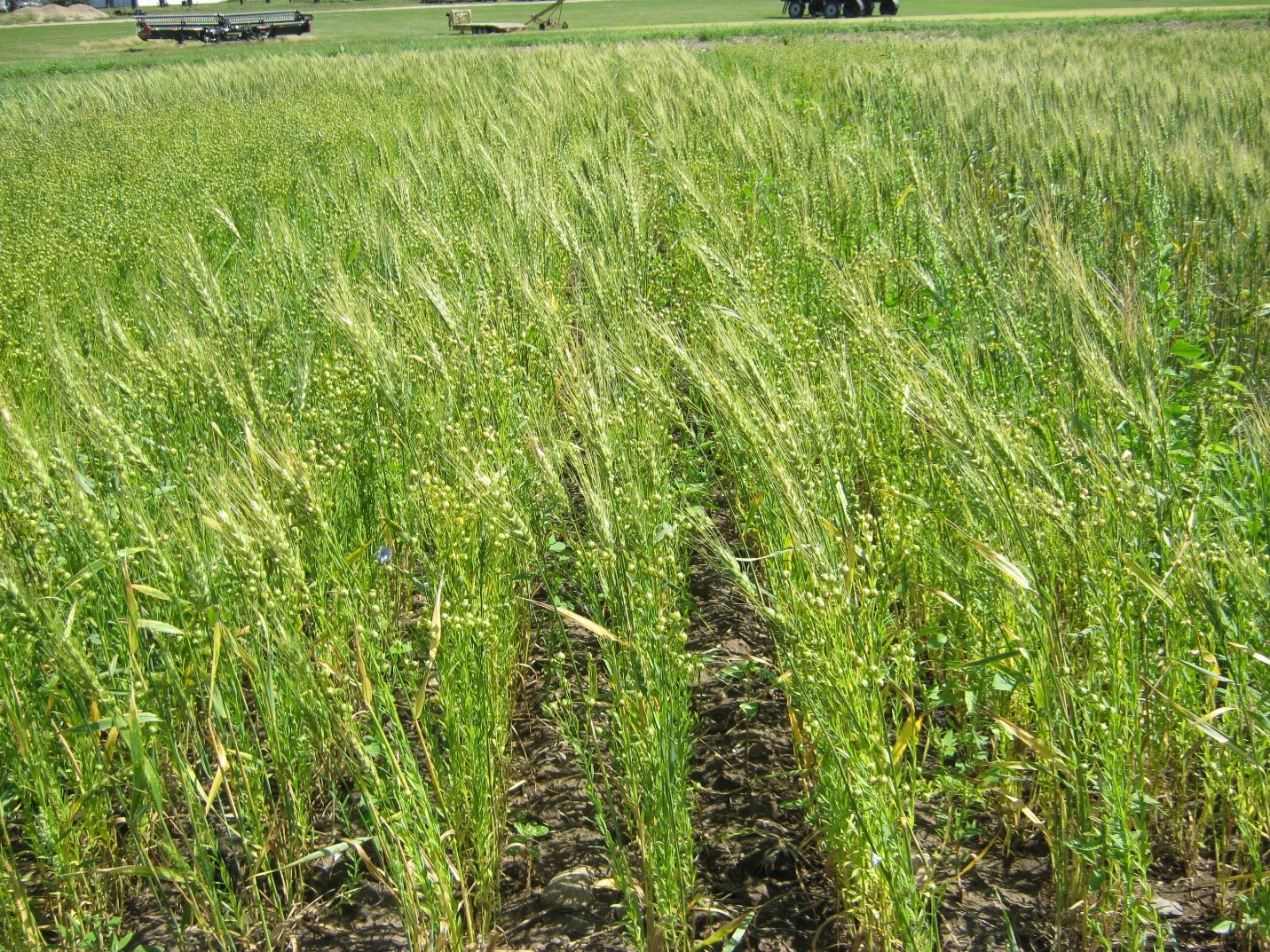 Organic wheat/flax intercrop on July 22 at the NDSU Carrington Research Extension Center.
Organic wheat/flax intercrop on July 22 at the NDSU Carrington Research Extension Center.
A demonstration planting of an intercrop planting known as “three sisters” was planted this season at the CREC. Three Sisters is commonly corn, dry beans and winter squash all planted together. We planted this combination late, on June 30, due to dry soil conditions. This is late for corn and dry beans so we improvised and planted sweet corn, green pole bean and summer squash or zucchini. The varieties used were True Gold sweet corn, Blue Lake green bean and Dark Star zucchini.
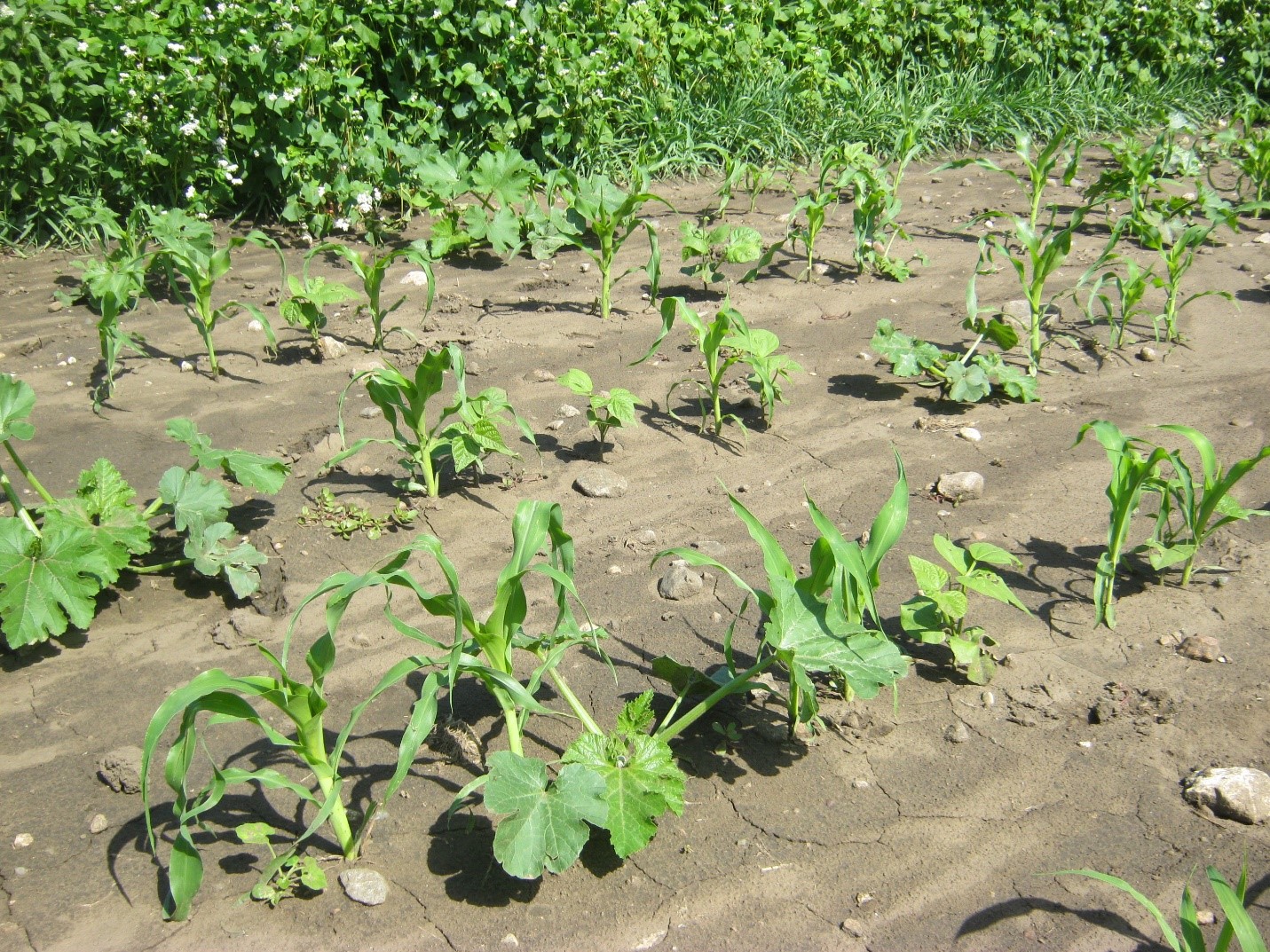 Corn, bean and squash intercrop, known as Three Sisters, on July 22 at the NDSU Carrington Research Extension Center.
Corn, bean and squash intercrop, known as Three Sisters, on July 22 at the NDSU Carrington Research Extension Center.
Steve Zwinger
Steve.Zwinger@ndsu.edu
Agronomy Research Specialist
Online Composting Workshop
North Dakota State University Extension, in conjunction with the University of Minnesota Extension, is hosting an online manure composting workshop.
The video content for the workshop will be posted online on Aug. 4, and a live follow-up online discussion webinar will be held on Aug. 11.
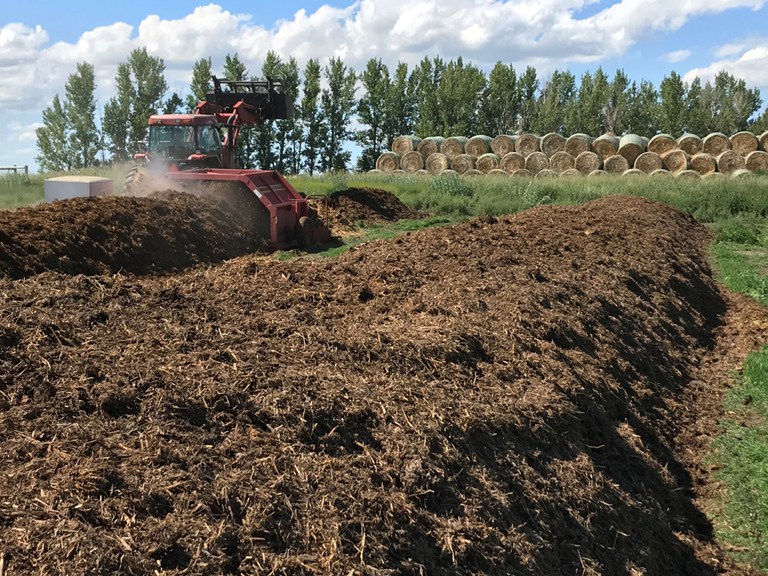
This workshop, sponsored by the North Central Region Sustainable Agriculture Research and Education program, will focus on the basics of turning raw manure into compost. During the live discussion, compost producers who make up the producer panel and the other workshop presenters will be available to answer questions.
Registration is required to access the content. To register, go to https://tinyurl.com/ManureCompostingWorkshop any time before the workshop date.
Topics for this workshop include:
- Site selection
- Temperature management
- Moisture management
- Turning the compost
- Spreader calibration demonstration
- Sampling demonstration
- Understanding analysis reports
- Economics
- Compost producer operation visits
- Compost producer question-and-answer session
Crop and livestock producers, large or small, are encouraged to participate in this online workshop. This is an excellent opportunity for people who have questions about composting to take a self-paced course while still getting to interact with producers and presenters during a live discussion session.
For more information, email mary.keena@ndsu.edu or cmodderm@umn.edu or visit https://www.ag.ndsu.edu/lem/2020-manure-composting-workshop.
Mary Keena
Mary.Keena@ndsu.edu
Extension Specialist
Is It Too Late to Correct for Nitrogen Deficiency in Corn?
Several corn fields have been under prolonged or frequent wet conditions where, there has been some N losses to denitrification (plant available nitrogen as nitrate is converted to unavailable nitrogen) and N leaching, depending on location and soil type. Older (lower) corn leaves show yellowing especially on the midribs from nitrogen deficiency.
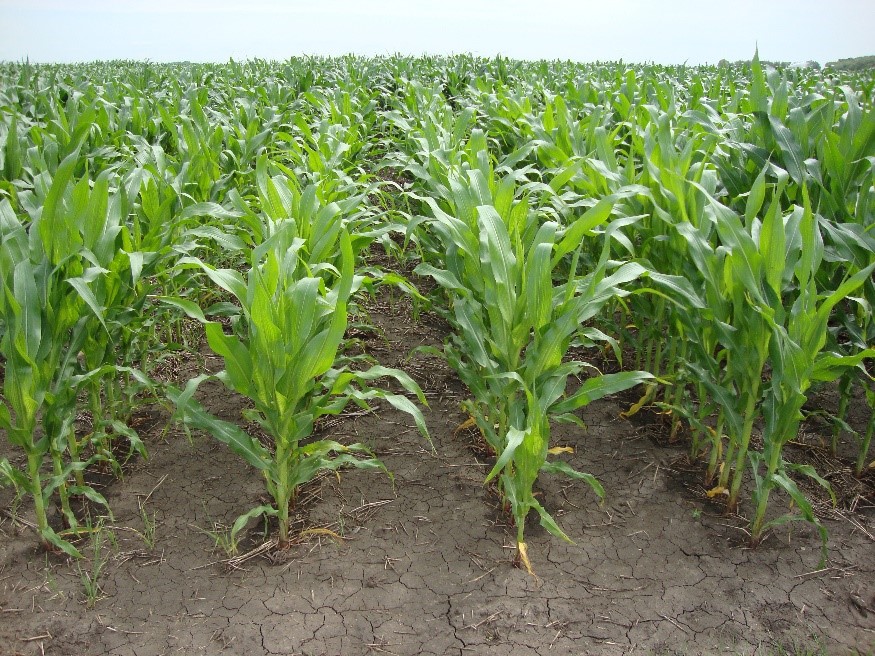 Nitrogen deficient corn at the NDSU Carrington Research Extension Center.
Nitrogen deficient corn at the NDSU Carrington Research Extension Center.
Should the North Dakota farmer apply nitrogen fertilizer to correct for N deficiencies in corn, and expect to improve yields and recoup the cost?
Mid-season N is recommended for corn between V5 to V8, but ideally between V5 to V6, when growth and yield response are most likely, and that full recovery of yield potential is expected following correction of the early deficiencies.
Beginning the second week in July, many of the corn fields are already at V8 to V10. Nitrogen applied after V8 can still result in significant yield improvement by increasing kernel size; but other yield components would have already been set. N deficiency can be corrected from V8 to V10 and up to V12 on some higher yielding fields, but with a declining likelihood.
Corn’s greatest need for nitrogen is from the V12 stage to the corn blister stage. Soil type heavily influences the side-dressing decision. High clay soils should have a planned split-application of nitrogen fertilizer due to the risk of nitrogen loss by denitrification. Sandy soils also have high risk of nitrogen loss due to leaching.
Mid-season fertilizer consideration
For medium to sandier texture soils, anhydrous ammonia is probably the best choice to side-dress corn, and UAN for high clay soils. UAN (28%) is a better choice than urea. UAN can be applied with a coulter approximately 2 inches deep, and anhydrous ammonia at 5 to 6 inches deep.
Also consider as the next option, UAN applied as a surface band using orifice nozzles between the rows. Corn injury can be reduced if a stiff hose which drags or nearly drags on the ground is configured to the stream bar.
Urea used for top-dressing on older corn plants can cause fertilizer burn or plant death and the least favorable nitrogen choice. Urea broadcast should be limited to 60 lb N/ac. Fertilizer placed in every other row is sufficient. Slow-release formulations should be avoided.
Additional informantion at: https://www.ag.ndsu.edu/cpr/soils/topdress-and-sidedress-options-for-solid-seeded-and-row-crops-06-06-13
Jasper Teboh, Ph. D.
Jasper.Teboh@ndsu.edu
Soil Scientist
V is for...Virtual
Did you think we were going to say “virus”? How about “video”? We like that better. Or, “variety trial”? That’s our favorite! But this week’s Center Points is about all of these “V’s.” The 61st Annual CREC Field Day, including our variety trials, is going virtual, via video, because of…that other v-word.
CREC Field Day(v)
Normally, as July begins, we’d be focused on pre-Field Day checklists, progressing through our plans and watching the weather, hoping for a pleasant Goldilocks day for everyone to see our agronomy, livestock, and fruit trials at our Field Day in mid-July. But COVID-19 has changed how we live, and it’s changed this year’s Field Day, too.
Especially for the CREC, where we traditionally host hundreds of people on four concurrent tours, this is a convenient method to present our research. Short, focused, topical videos will be premiered on Tuesday, July 14, and remain online as long as the information is viable. You will find the videos here: https://www.ag.ndsu.edu/carringtonrec/field-days/field-days.
Change is good. We’re hoping to reach thousands of people during the lifetime of these videos. And let us assure you, it was a beautiful day when we recorded. All that was missing was you, and we’re hoping to get to a new normal for next year’s Field Days and tours.
We would like to call special attention to the efforts of Bruce Sundeen from NDSU Agriculture Communication, who traveled to the CREC and to each of our sister RECs to capture video and audio clips before editing those files and adding graphics and images into professional videos.
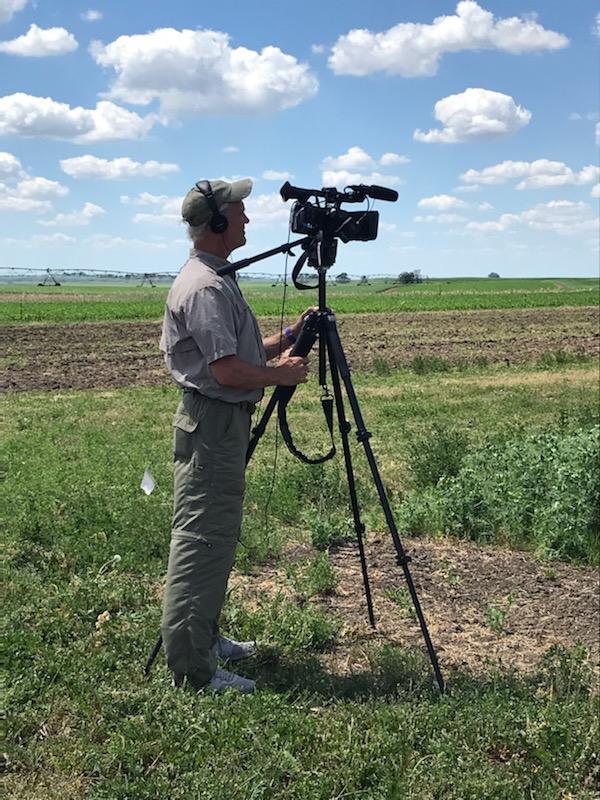
Bruce Sundeen, NDSU Agriculture Communication, filming at the Carrington Research Extension Center.
If you have questions about any of our research and Extension programs, contact us at 701-652-2951 or NDSU.Carrington.REC1@ndsu.edu for a conversation or private guided tour.
Linda Schuster
Linda.Schuster@ndsu.edu
Administrative Secretary
Optional Weed Science Education Opportunities for Traditional Crop Management Field School
The Carrington Research Extension Center (CREC) will not be conducting its annual Crop Management Field School this year because of the COVID-19 pandemic. However, as a partial replacement, two exhibits are currently available for viewing at the CREC: weed arboretum and herbicide site-of-action (SOA). Both of these exhibits have been popular and rated highly during past field schools.
Weed arboretum
About 60 live weeds are on display in various stages of development. The weeds are grouped by biology including annual broadleaves and grasses, winter annuals, biennials, perennials. Also, the majority of North Dakota noxious weeds are present.
The display is located south of the CREC headquarters. Individuals can visit the site anytime. Please check in at the main office. Also, tours can be arranged to provide details on weed identification, biology and control.
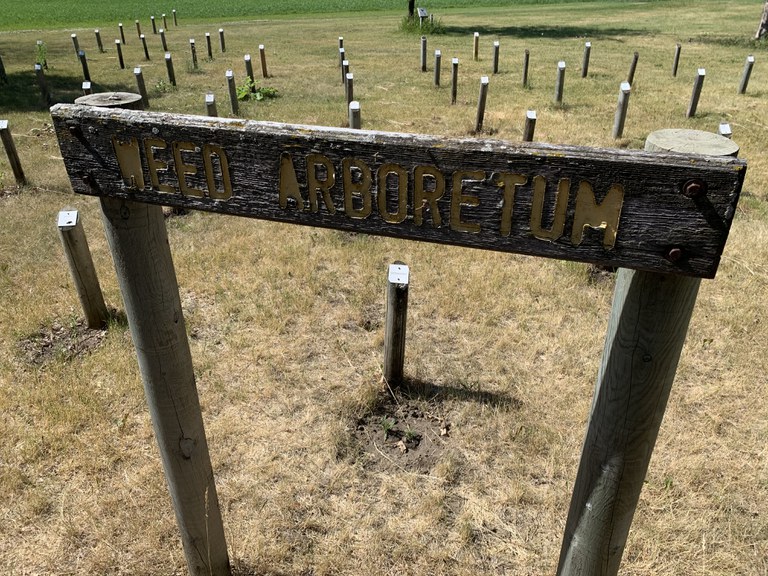
The entrance to the Weed Arboretum at the NDSU Carrington Research Extension Center.
Herbicide SOA
Six crops (spring wheat, corn, field pea, soybean [two herbicide tolerant types] and sunflower) were planted in strips and were treated with herbicides that represent eight SOA groups. The herbicides and respective SOA groups (in parenthesis) are: Select Max (1), Express (2), Engenia (4), Roundup PowerMax (9), Liberty 280 (10), Flexstar (14), Gramoxone (22) and Balance Flexx (27). Injury symptoms associated with each SOA group can be observed in the crops and weeds present in the exhibit.
Details on herbicide SOA can be found in the NDSU Extension 2020 ND Weed Control Guide.
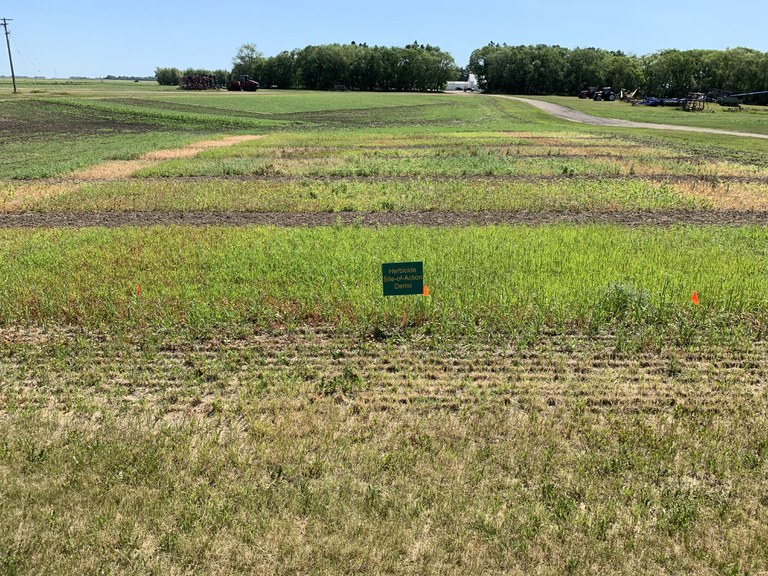
The herbicide site-of-action exhibit at the NDSU Carrington Research Extension Center.
Video presentations on selected topics from both exhibits were taped last week and tentatively will be posted on the CREC website during the first half of July. Presenters are Joe Ikley, NDSU Extension weed specialist and Greg Endres, NDSU Extension cropping systems specialist.
Greg Endres
Gregory.Endres@ndsu.edu
Extension cropping systems specialist
Opportunities for Feedlot Pen Surface Improvements
Poor pen conditions due to early snowfall and rainy weather last fall plagued cattle feeders in the much of North Dakota. Muddy conditions have been shown to decrease intake, gain and feed efficiency resulting in increased cost of gain. While the use of bedding is a well-accepted way to mitigate these affects, the need to clean pens and rebuild and pack pen surfaces to re-establish proper drainage is necessary for optimizing long-term efficiency.
The majority of feedlot pens are soil based with mounds created to provide dry areas for bedding. However, in recent years, more feedlot operations in the Northern Plains have been looking at alternative pen surface materials to decrease the annual expenses associated with hauling fill (clay or gravel) back into pens to maintain grade and allow for proper drainage. Hard surfaces including fly ash, concrete, and a newer product known as roller compacted concrete, which is being used in a number of feedlots in western Canada, allow for longer lasting pen surface conditions. These hard surfaces also come with an increased cost.
Beyond advantages to pen surface maintenance and depending on wastewater holding capacity and permitting regulations in your given state, utilization of solid surfaces, including concrete, may allow for greater stocking density of feedlot pens. As an example, by moving from an unpaved open lot (2-4% slope) to a paved surface with the same slope, stocking rate increases dramatically as space requirements decrease from 600ft2 to 55ft2 for feedlot cattle (Table 1). Producers should also consider other management practices, as well as bunk space, as part of their decision process.
Table 1. Pen and bunk space recommendations for beef cattle.
As I conclude this Center Points, I would like to share some improvements we are making at the NDSU CREC livestock unit. Like many operations, we were struggling with the recurring costs associated with feedlot pen maintenance. Fly ash was placed in our pens in the late 90’s, but this material has deteriorated over time. We have moved forward with the process of concreting a portion of our feedlot pens. This will provide advantages in the long-term growth of our research program. For those of you wishing to see the new renovations please call 701-652-2951 or stop at the main office. We’ll get you checked in and have someone show you around. I wish you a productive summer.
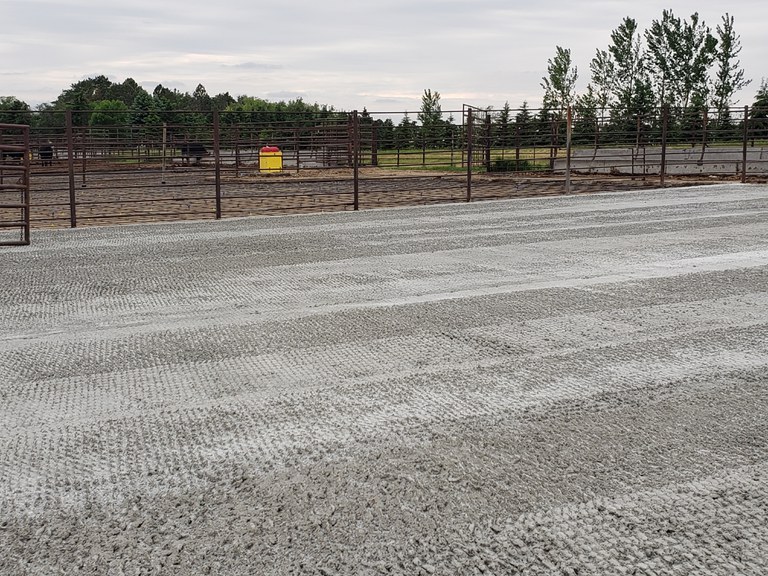 Concrete curing in a feedlot pen at the NDSU Carrington Research Extension Center.
Concrete curing in a feedlot pen at the NDSU Carrington Research Extension Center.
Bryan Neville, Ph.D.
Bryan.Neville@ndsu.edu
Animal Scientist
Should We Combine RoundUp and Liberty?
Soybean herbicide application decisions are evolving daily in 2020. The Extend system has offered an excellent tool in managing some important glyphosate resistant weed species. The Enlist system offers improved control on many of these weeds as well, however kochia is a notable exception. Kochia management with 2,4-D is not a good option. The fortunate thing with Enlist is that is comes with both RoundUp and Liberty traits. The question then becomes which of these products are OK to mix during a single application. There have been several products made in past years that have both RoundUp and Liberty premixed, however, many customers were not happy with performance and there is currently no such product in the U.S. The issue is concern over antagonism between the two chemistries.
The 2020 growing season will be the third year of testing different combinations of RoundUp, Liberty, and Enlist at the CREC. After reviewing the results, the one thing that is clear is that the results are not. Most of the time combining the products results in control that matches what either product does alone. In other words, there has usually been no increase in control by combining the products. There have been several instances where combining the products has reduced control, compared to separate applications. Notably, grass control was reduced when Liberty was added to RoundUp. A similar phenomenon was noted in 2018 in common lambsquarters, but not in 2019. An important management note here is that the Liberty appears to antagonize the RoundUp more so than the other way around.
How does this change when we talk about glyphosate-resistant species?
If the products were combined, conditions need to be optimized for Liberty efficacy. This means 20 GPA volume and finer droplet size. To be clear, this needs to be viewed as a Liberty application. Figure 1 shows some of the 2020 results of the combinations. In this case, the control of kochia followed what the Liberty application was capable of (applying to kochia 2” or less), which was about 95% control. About 40% of the plants at this site were resistant to RoundUp.
What is the recommended practice?
Split applications are best to avoid any potential antagonistic problems. Antagonism is not as severe as initially thought, but can be present, and can ultimately lead to future weed resistance problems. If products were combined it is critical to apply to optimize Liberty activity.
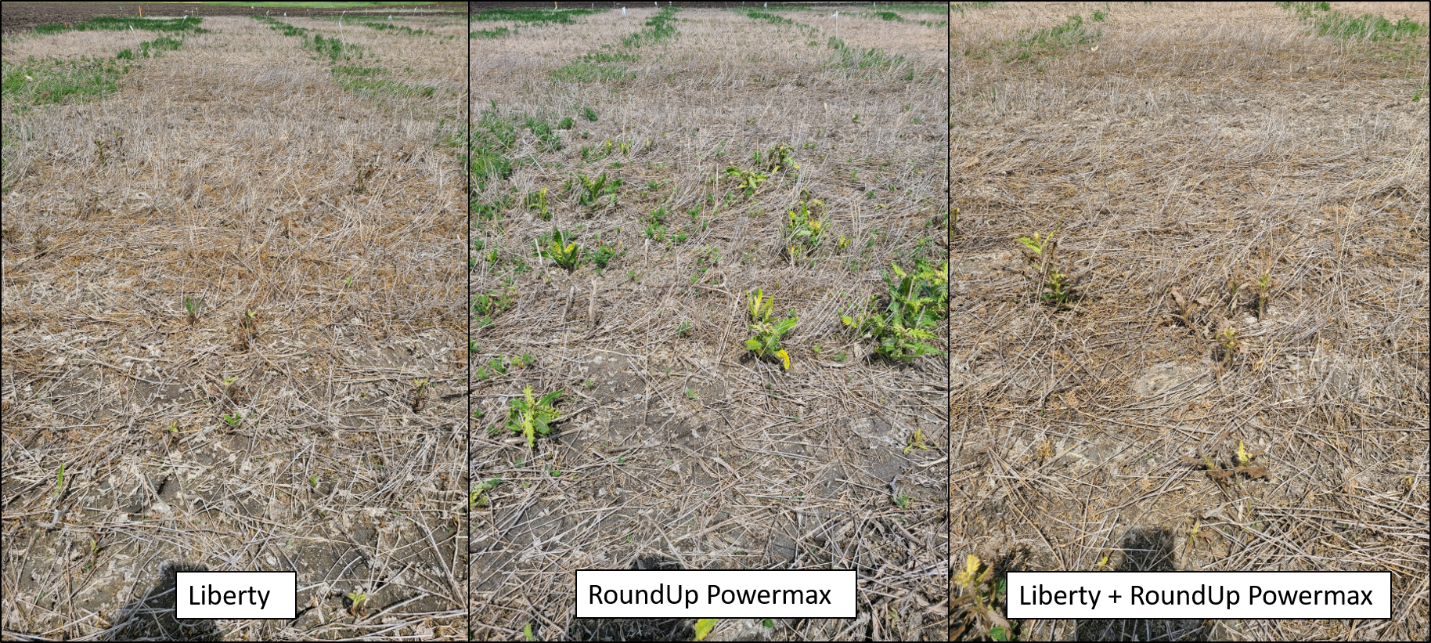
A snapshot of trial results at the NDSU Carrington Research Extension Center comparing Liberty, RoundUp and a combination of the two.
Mike Ostlie, Ph. D.
Mike.Ostlie@ndsu.edu
Research Agronomist
Lupin, Renewed Research of an Alternative Crop
The evaluation of new alternative crops has been a long-standing objective within the mission of the CREC’s agronomy research program. These evaluations assess crop adaptation and often follow with studies to refine production practices on those crops exhibiting potential in our region. Crops such as sunflower, soybean, canola and field pea are all examples of crops that at one time were considered a new alternative crop when research at the Center was initially conducted. These crops are now widely grown or common to producers in the region and the state.
One of the alternative crops the CREC is evaluating once again is lupin. Lupin is a cool-season legume that is commercially grown in various regions of the world, notably Australia and some European and South American countries. The crop is primarily of interest due to the high protein content of the seed with levels ranging from the mid-20’s to as high as 40 percent depending upon the species. Most lupins are grown to be used as livestock feed, especially for ruminants. Lupins are used as a human food source although this represents a minor part of the world market.
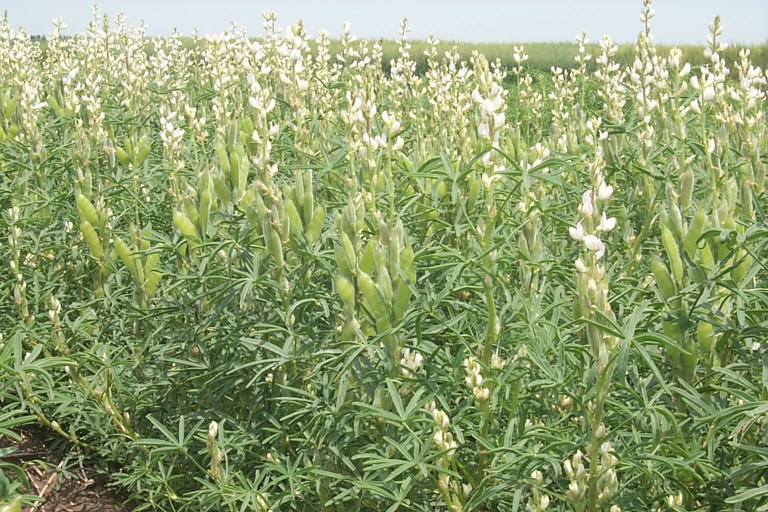 Blue, narrow-leaf, lupin approaching end-bloom stage of development.
Blue, narrow-leaf, lupin approaching end-bloom stage of development.
The CREC conducted extensive research on lupin in the late 1980’s to the mid-1990’s on white (Lupinus albus), blue or narrow-leaf (L. angustifolius), and yellow (L. luteus) types. Research continued intermittently in subsequent years. Information gained from this research provided insights into proper production practices and defined that the crop was adapted to our region when specific genetic lines were grown. Lupin varieties with a more determinant growth habit were better adapted than the indeterminant varieties. White lupin was identified as having good yield potential with seed yields of 30 to 40 bushels per acre most common. Plant density studies with white lupin indicated stable yields across a range of populations and row spacings. The high moisture conditions of the mid-1990’s exposed lupins susceptibility to a disease known as anthracnose. Fungicides that are now available may provide an option to manage this pathogen. In crop rotation trials, lupins were shown to effectively fix atmospheric nitrogen and are known to produce proteoid roots to mobilize mineral phosphorus that is otherwise bound. An attractive feature of the crop is that at maturity the seed pods are positioned at the top of the plant supported by strong stems.
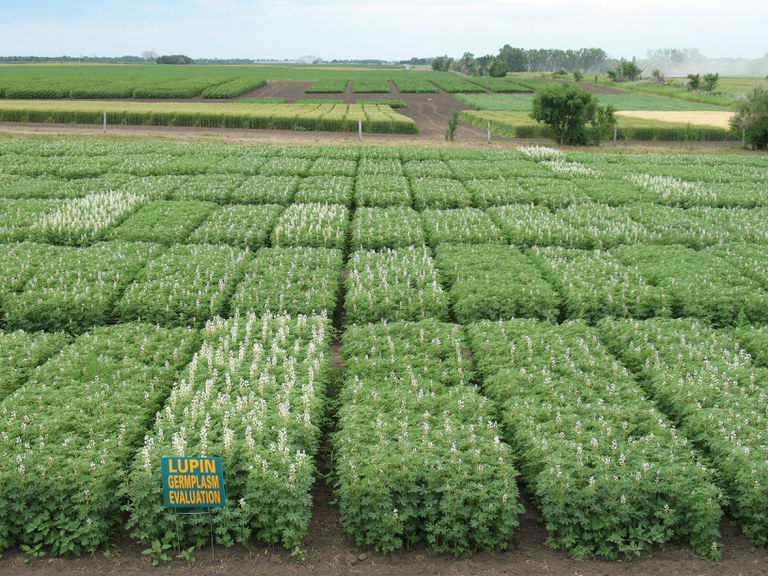
Evaluation of experimental lines of white lupin at the CREC.
Current lupin research was re-established to evaluate adaptation of new introductions and to update crop performance data. Experimental lines yielded favorably with the late-season challenges of 2019, as they averaged a yield of 55 bushels per acre. The seed characteristics of lupin may be of renewed interest for human consumption as modern processing technologies create seed product differentiation that didn’t exist previously and demand for plant-based protein and associated products has increased.
Blaine G. Schatz
Blaine.Schatz@ndsu.edu
Director/Agronomist
The C, D and F Seasons
Was it truly a spring season? Our snow left with a near perfect melt. And yet, there was water everywhere. The seasonal birds came back and covered the landscape with singing, nests and new hatchlings. Cropping decisions were made and crops were planted where possible. But…harvest was never completed from last fall. The CREC had 140 acres of durum, 65 acres of brown flax and 70 acres of soybeans that were not harvested. This represents roughly 18% of our foundation seed base.
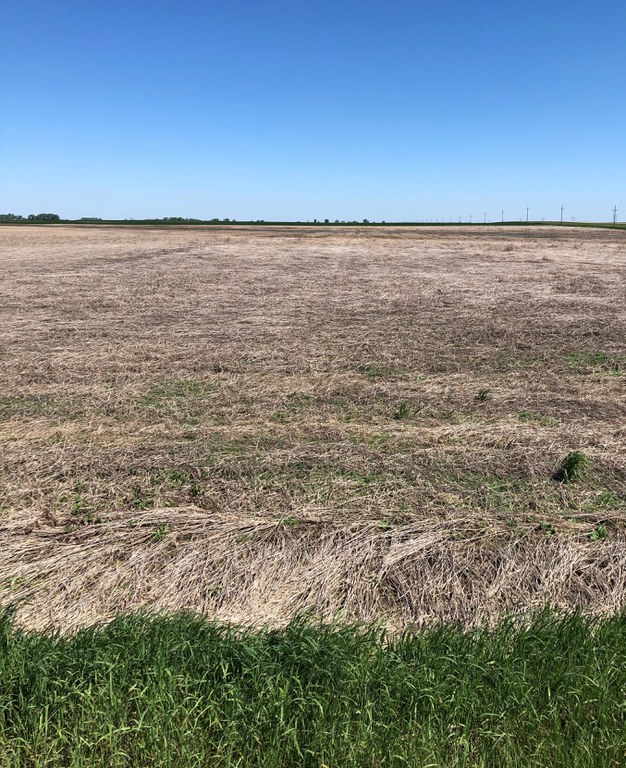
Fall 2019 crops being harvested in Spring 2020 at the NDSU Carrington Research Extension Center.
Season C, the COVID-19 virus and foundation seed customers. Early March was when the virus was becoming monitored in the US. By late March, all NDSU campus buildings were closed to the public. The CREC followed by locking all buildings and emailing out a set of guidelines to our seed customers to help reduce the risk of spreading the virus. Our seed customers, their hired men and delivery drivers are great people and our instructions were well received and followed. Thank you!
Season D, planting delays. Foundation seed planting started on May 1st with field peas. Our typical starting date is close to April 20th. With cool April temperatures, unharvested fields and almost 25 inches of moisture from last June through November, the foundation seed planting progress has been slow. Many changes have been made to our first crop planting plan. The CREC foundation seedstocks program is planting 9 crops. There are 32 varieties and 9 are experimental. Our final plantings will depend on the last few experimental varieties coming in. The CREC foundation seedstock variety planting list consists of:
Crops and numbers of varieties of CREC foundation seedstock being grown in 2020.
Season F, field inspection report deadline is June 15th. It is coming way too fast! Here are some important report reminders:
- Durum fields need a history of no wheat for the last two years.
- Send in your bulk certificate or bag tag, a field map and payment. The payment schedule is on the back page of the report.
- Don’t forget to sign and date the report. Applications are available online, at your local Extension office at the North Dakota Seed Department at NDSU.
Finally, important field inspection requirements:
- The isolation strip between fields needs to be at least 5 feet wide. Acceptable strips are leaving bare ground at planting or using a mower, a fence line or grass ditch.
- Weed control is always important. Seek spray advice if you have any weed control questions.
Good luck with your season!
Dave Copenhaver
David.Copenhaver@ndsu.edu
CREC Seedstocks Research Specialist


